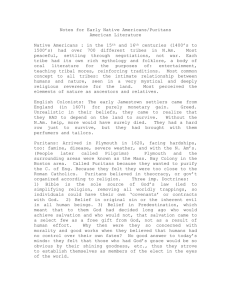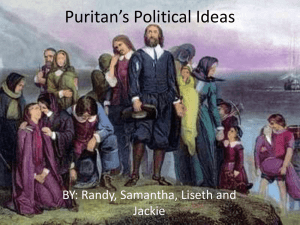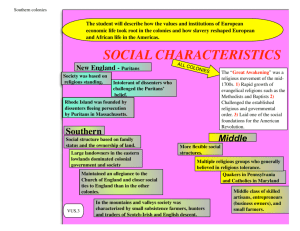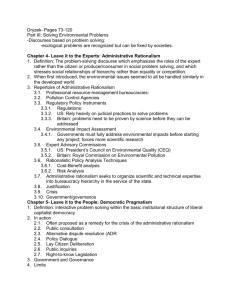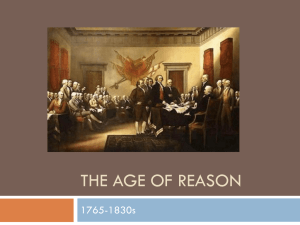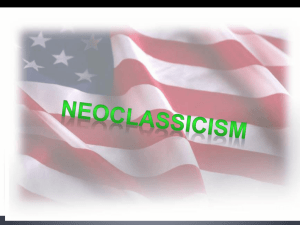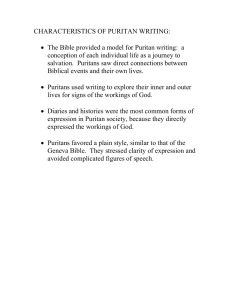Elements of Literature Sixth Course
advertisement
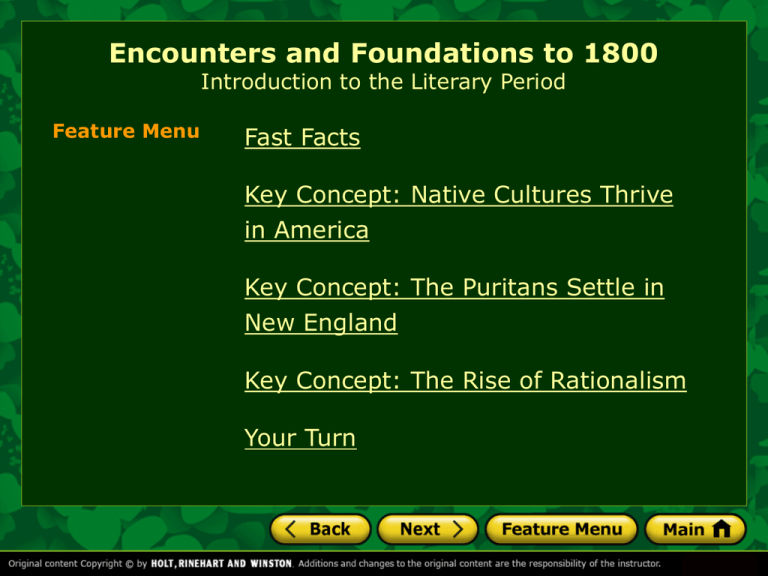
Encounters and Foundations to 1800 Introduction to the Literary Period Feature Menu Fast Facts Key Concept: Native Cultures Thrive in America Key Concept: The Puritans Settle in New England Key Concept: The Rise of Rationalism Your Turn Encounters and Foundations to 1800 Fast Facts Historical Highlights • Dekanawida, a Mohawk visionary, unites American Indian peoples with the Iroquois Confederacy, c. 1500. • Pilgrims land at Plymouth in 1620. • Colonists battle the British in the Revolutionary War from 1775 to 1783. Encounters and Foundations to 1800 Fast Facts Literary Highlights • Columbus’s journal, published in 1493, describes the North American continent and its people. • Anne Bradstreet publishes the Tenth Muse in 1650. • Benjamin Franklin publishes Poor Richard’s Almanac in 1732. [End of Section] Key Concept: Native Cultures Thrive in America History of the Times • Before the first Europeans arrived, American Indians had lived here for thousands of years. • The first interactions between Europeans and American Indians involved trading. Key Concept: Native Cultures Thrive in America History of the Times • Mutual curiosity led to increasing interdependence between the cultures. • Europeans relied on American Indians to teach them survival skills. • Indians were eager to acquire European firearms, textiles, and steel tools. The Granger Collection, New York • Settlers, however, exposed native populations to diseases. Key Concept: Native Cultures Thrive in America Literature of the Times • Native American literature is rooted in oral tradition. • Storytellers were highly valued by their communities. • Oral traditions captured myths of origin and histories of certain Native American groups. • Explorers wrote detailed accounts of the American Indians they encountered. Cabeza de Vaca in the Desert by Frederic Remington. Key Concept: Native Cultures Thrive in America Comprehension Check What interactions took place between European settlers and Native Americans? [End of Section] Key Concept: The Puritans Settle in New England History of the Times • The Puritans’ moral, ethical, and religious convictions helped shape American character. • Puritans believed in thrift, hard work, and self-sufficiency. • They also believed that a spiritual contract existed between God and humanity. Key Concept: The Puritans Settle in New England History of the Times • In the Mayflower Compact, the Puritans set out a new form of government. • This contractual agreement became a model for American constitutional democracy. • Because political authority was based on religious tenets, the political views of Puritans were sometimes uncompromising and harsh. Key Concept: The Puritans Settle in New England Literature of the Times • The Bible provided a model for Puritan writing. • Each life was viewed as a journey to salvation, so Puritans connected Biblical events to events in their own lives. • Diaries and histories were the most common forms of literature; they reflected a sense of intense piety and strict self-discipline. Key Concept: The Puritans Settle in New England Comprehension Check Explain three ways in which Puritan beliefs influenced the colonists’ lives. [End of Section] Key Concept: The Rise of Rationalism History of the Times • European political and social turmoil led people to question the divine right of monarchs. • A new movement, the Enlightenment, began to spread, fostering a belief in rationalism. • Rationalists believe that reason and intellect, rather than revelation, lead to discoveries of scientific and spiritual truth. • Inspired by rationalism, the founders of the new country set forth ideals of religious tolerance and individual liberty. Key Concept: The Rise of Rationalism Literature of the Times • Most American writing was in response to unfolding political and social events: independence from Britain, the struggle of women to gain equality with men, or the struggle of enslaved African Americans to end slavery. • Pamphlets, letters, and poetry were popular forms of literature. • The most famous piece of literature of the time period was Benjamin Franklin’s autobiography. Key Concept: The Rise of Rationalism Comprehension Check How did rationalism differ from Puritanism, and what effect did rationalism have on the new American political system? [End of Section] Encounters and Foundations to 1800 Introduction to the Literary Period Your Turn With a partner, summarize the main historical events and important pieces of literature that shaped this time period. Try to use the following Academic Vocabulary words in your analysis. aspect interpret cite perspective contemporary [End of Section] The End
